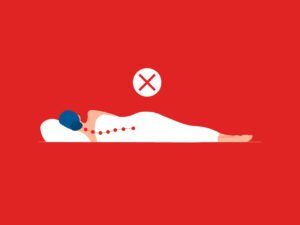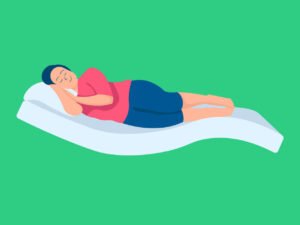Proper sleep improves concentration, enhances the immune system, helps the body heal, regulates appetite, and improves athletic performance.
There are many things to be mindful of when deciding on a sleep position.
This article will discuss the best position to sleep with a cold while exploring the pros and cons of common sleeping positions.

Contents
How Sleep can Help Combat a Cold
Symptoms of a cold include a sore throat, runny nose, congestion, coughing, and body aches.
In severe cases, high fever and shortness of breath might occur.
To combat a cold, you want to strengthen your immune system, alleviate or reduce inflammation, and boost energy with good breathing.
These can all be achieved with proper sleep.
A healthy immune system relies on good blood circulation.
Circulation of the blood supplies enough oxygen and nutrients to the body’s vital organs (heart, lungs, kidney, liver, and spleen) for them to function.
Some sleeping positions are better than others for increasing blood circulation and for promoting good breathing.
Some positions can aggravate aches and pains, while others can reduce them.
If you regularly feel good when you wake up and healthy throughout the day, you probably don’t need to change your sleeping position.
However, if you have a persistent cold and you’re waking up sore or not feeling well, you may want to consider changing your sleeping position.
How We Sleep
According to the Better Sleep Council, the fetal position is the most popular sleeping position, adopted by 47% of Americans.
This is a side position in which the knees are bent and curled toward the torso, with the chin titled down.

The Better Sleep Council notes that 54% of women and 39% of men sleep in the fetal position.
The freefall position, in which you lie on your stomach with the head turned to the side and arms under a pillow, is how 17% of Americans sleep.
Meanwhile, 13% of the population use the yearner position (sleeping on the side with the arms stretched out in front), 11% choose the soldier position (lying on the back with the arms down and close to the body).
7% prefer the starfish position (sleeping on the back with the arms up near the head).

6% adopt the log position (lying on the side with the arms close to the body).
Sleeping on Your Side
Lying on your side might be the best position to sleep with a cold, but some side-sleeping positions can be more effective than others.
Which side is best to sleep on, left or right?
Many experts believe lying on the left side is the best sleeping position for blood circulation.
Sleeping on the right side, on the other hand, makes it more difficult for the blood to flow to its proper destination, and circulation is limited by pressure being exerted on blood vessels.
Blood is circulated and flows back to the right side of the heart when it pumps blood out to the body.
Your heart needs to work harder when you sleep on your right side since blood vessels are being compressed by your body weight, making it more difficult to return blood to your heart.
Since good blood circulation is important for a healthy immune system, an argument can be made that sleeping on your left side is the best position to sleep with a cold.
However, according to Sleep.org, patients with heart failure prefer sleeping on their right side, perhaps to avoid discomfort and shortness of breath.
Is the fetal position bad for cold?
The fetal position, isn’t the best for combating a cold.
In a video on their YouTube channel (Bob & Brad), physical therapists Bob Schrupp and Brad Heineck compared sleeping in the fetal position to a crimped garden hose.
Just as water flow is reduced when the hose is bent, blood flow throughout the arteries is reduced when you sleep with your knees bent and curled up.
Which side is better to sleep on for digestion?
Sleeping on your left side, may be beneficial for your digestive system.
Right-side sleeping may aggravate heartburn.
If you have trouble sleeping due to heartburn or other discomforts, it will be difficult to fight off a cold.
Can sleeping in the wrong position cause inflammation?
Reducing inflammation is a key component to battling a cold.
The yearner sleeping position can put pressure on the arm and blood vessels, which can restrict blood flow.
You may experience discomfort in your arm and shoulder in this position, especially when sleeping on a firm mattress.
Sleeping this way can also aggravate acute elbow injuries.
To wake up without aches and pains, you may want to choose the log position instead of the yearner position if you sleep on your side.
Additional benefits of side sleeping
Sleeping on your side can reduce back and neck pain, while also reducing snoring.
It opens your airways better than any other position.
Side-sleeping can reduce the frequency of sleep apnea breathing irregularities.
Good breathing is important for combating a cold.
This provides another reason to roll onto your side as the best position to sleep with a cold.
Sleeping in this position can also improve cognition.
As for drawbacks to side-sleeping, it can make you sore if you suffer from arthritis, it can cause wrinkles since your face is pressed down on the pillow, and curling up in the fetal position can restrict your diaphragm and prevent you from breathing deeply.
Pregnancy and Sleep
Pregnant women are advised to sleep on their left side for the best blood circulation for her and the baby.
The American Pregnancy Association recommends this sleeping position for pregnant women.
In a side-lying position, the least amount of pressure is placed on the veins and internal organs.
Sleeping on the left side prevents the uterus from compressing the liver.
With good circulation, potential swelling is reduced.
It becomes difficult for pregnant women to sleep on their stomach as the belly expands.
They also shouldn’t sleep on their back, especially in the third trimester.
The pressure of the baby can restrict blood circulation for her and the baby in this position, and sleeping on the back may increase the risk of stillbirth.
It is important for pregnant women to boost blood flow, reduce aches and pains, and alleviate discomforts such as dealing with a cold for the health of her and the baby.
These aims can best be achieved by sleeping on the left side.
Sleeping on Your Back
While sleeping on your side (specifically, the left side) is generally regarded as the best sleeping position for blood circulation, sleeping on your back also has advantages.
Known as the supine position, sleeping on your back exerts less pressure on your shoulders than side-sleeping, and it can reduce headaches, hip pain, and knee pain.
The body rests in a neutral position, helping to alleviate aches and pains.
Weight and pressure are evenly distributed on the spine, neck, and joints.
Placing a pillow under the knees helps to maintain the natural curve of the spine.

If your cold symptoms include headaches and joint pain, lying on your back might the best position to sleep with a cold.
However, sleeping on your back can make certain conditions such as snoring and sleep apnea worse.
That’s because when you are in a deep sleep state, the airway muscles become relaxed, and gravity might make the back part of your tongue collapse and block part of the airway.
Also, the starfish position can cause shoulder discomfort.
Your neck can be strained if you lie on your back without a supportive pillow.

Furthermore, sleeping on your back can worsen congestion, a common symptom of a cold.
Sleeping on Your Stomach
Of all the common sleeping positions, lying on your stomach, known as the prone position, is regarded as the worst.
With the neck turned to almost a 90-degree angle from the body, the position can cause neck pain.
Being in a back-bending position for that long can cause lower back pain.
Kevin Wade, a neurosomatic therapist, said in a video on the St. John-Clark Pain Treatment Center YouTube channel that sleeping on the stomach puts the cervical spine into a twist and the lower back tends to curve too much.
People who sleep on their stomach don’t turn side to side and make adjustments during their sleep, which is also an advantage of sleeping on your back.
However, this can contribute to neck pain since people who sleep on their stomach tend to turn their head to the same side all the time.
Sleeping on your stomach may improve digestion, but the drawbacks outweigh the benefits of this sleeping position.
If your cold symptoms include body aches, sleeping on your stomach will not speed up healing.
Determining the Best Position to Sleep with a Cold
The best position to sleep with a cold depends on many factors, such as which cold symptoms are present and how the individual responds to different sleep positions.
Lying on your side (specifically, the left side) is viewed as the best sleeping position to boost blood flow, which strengthens your immune system.
Sleeping on your side is also the best position for opening your airways, making it easier to combat a cold.
To soothe an achy body, which often comes with having a cold, some people prefer to sleep on their side and others prefer to sleep on their back.
All sleeping positions have potential advantages and disadvantages.
If you suffer from aches and pains or have a medical condition that could be adversely affected by how you sleep, consult with your doctor about your best sleeping position.
If the position you use is working for you, it’s best to stick with it.
Lifestyle Factors That Affect Sleep
Doing beneficial things for your body throughout the day will improve your sleep as you battle a cold.
Nutrition
Make sure to drink plenty of water.
According to SleepScore Labs, your body loses water through sweat, mucus, and other immune responses when you’re dealing with a cold, increasing the amount of water you need to drink.
Follow a diet that is high in fiber, vitamins, minerals, and antioxidants.
Choose lean protein sources, select whole grains instead of refined grains, limit saturated fat consumption, and incorporate a good amount of healthy fats.
A healthy diet helps you fight off a cold and enhances your sleep.
Don’t have a big meal right before going to bed.
Exercise
Aim for at least 30 minutes of exercise a day.
Incorporate cardio (such as walking, running, swimming, and cycling) and strength training (such as bodyweight exercises, weight training, and training with resistance bands), balance training, and flexibility training.
Exercise promotes blood flow, increases your energy, enhances your mood, and improves your sleep.
Relaxation
Make sure to go to bed relaxed and in a positive frame of mind, with the mind free of distractions. Yoga, light stretching, reading, and puzzles are all good activities to do before going to bed.
Being relaxed reduces blood pressure and boosts your immune system.
Take a hot shower 90 minutes before going to bed to loosen up mucus and clear your sinuses.
The warmth of the shower will also help to relax your muscles, improving your sleep.
Drink a warm beverage 60 – 90 minutes before bedtime such as an herbal tea to soothe a sore throat.
Final Words…
Any steps you can take to reduce cold symptoms before going to bed will improve your sleep and get you back to feeling healthy.
While numerous factors determine the best position to sleep with a cold, getting a comfortable sleep from whichever position you choose can bring many health benefits.



